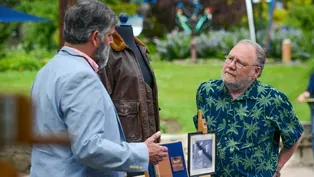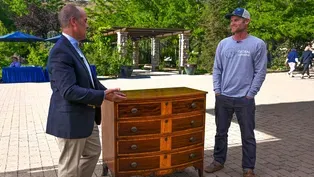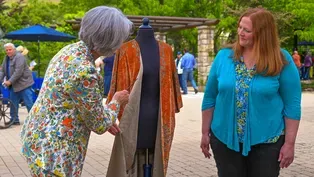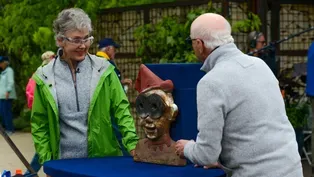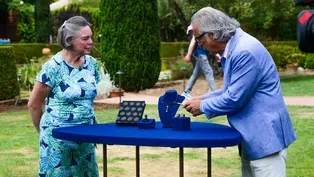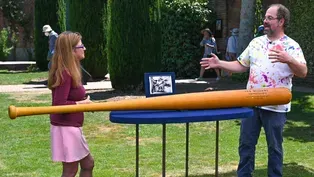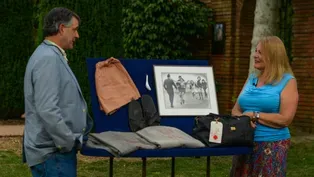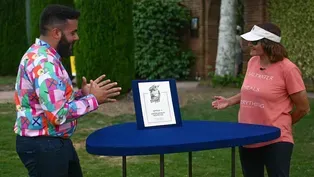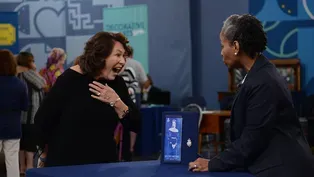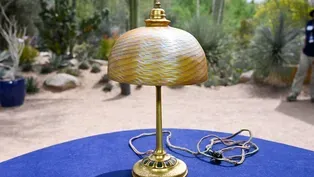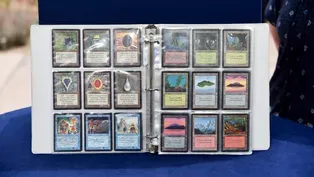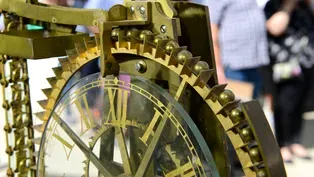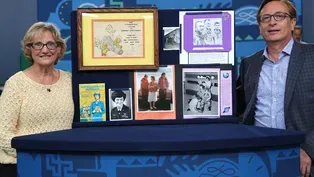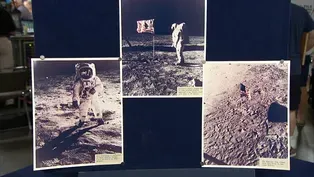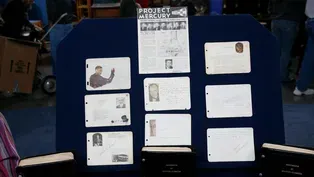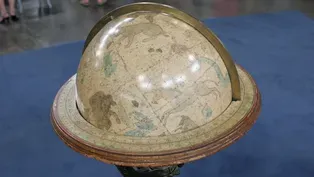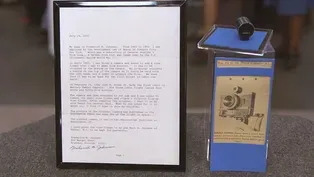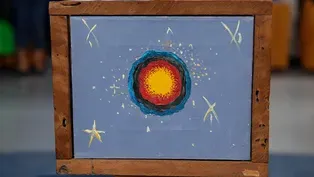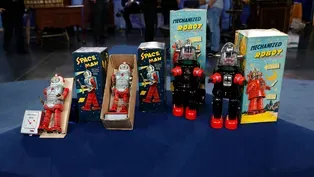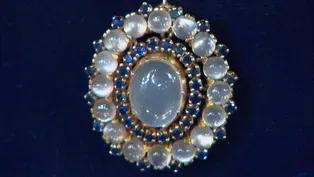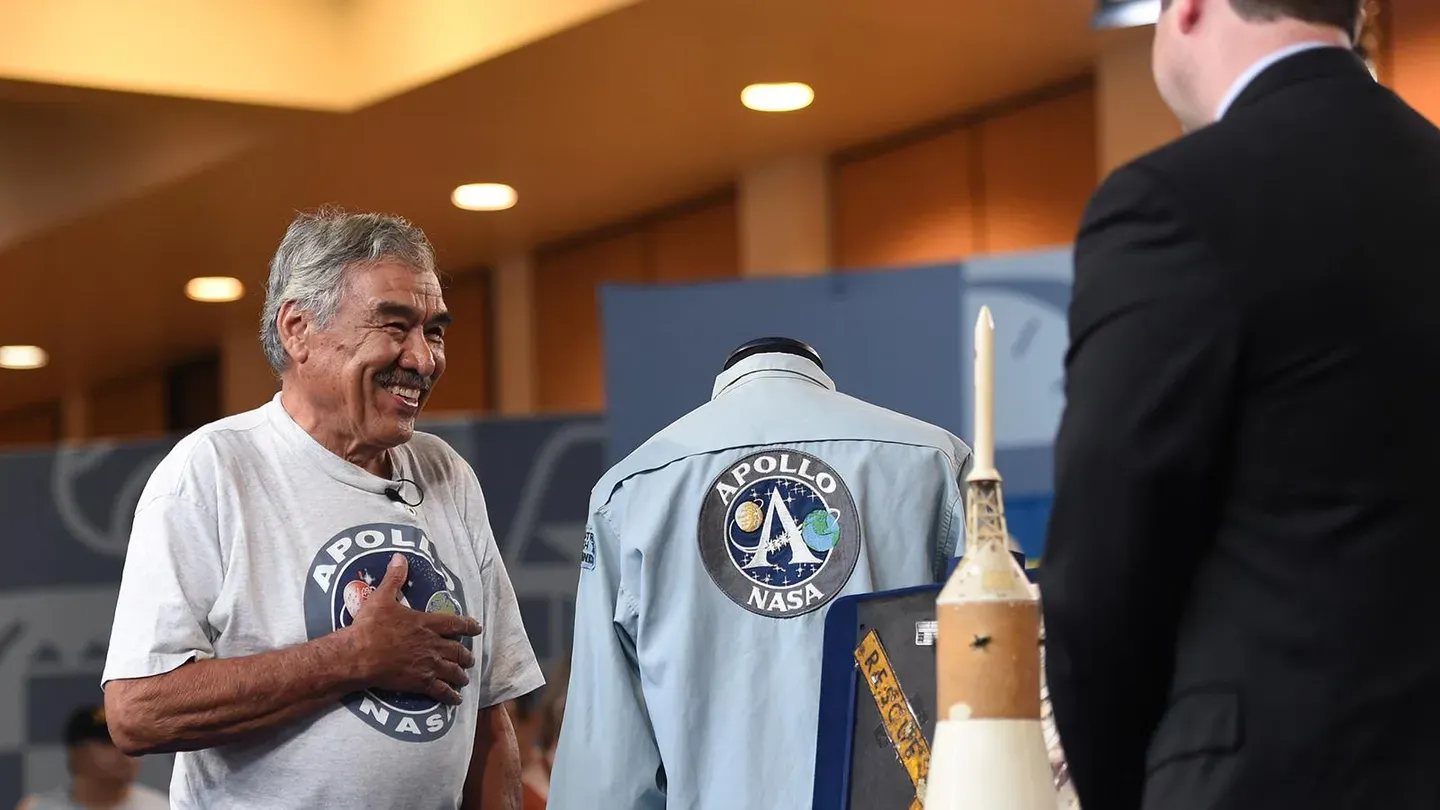

RECUT: Out of this World, Part 2
Special | 21m 48sVideo has Closed Captions
Explore the universe of space-themed treasures in this bite-sized episode of RECUT!
Explore the universe of space-themed treasures including an E. & G. W. Blunt celestial globe from around 1864, a 1963-1967 Pearl Tucker NASA archive, and Japanese Spaceman & Robot toys in this bite-sized episode of ANTIQUES ROADSHOW RECUT!
Problems with Closed Captions? Closed Captioning Feedback
Problems with Closed Captions? Closed Captioning Feedback
Funding for ANTIQUES ROADSHOW is provided by Ancestry and American Cruise Lines. Additional funding is provided by public television viewers.

RECUT: Out of this World, Part 2
Special | 21m 48sVideo has Closed Captions
Explore the universe of space-themed treasures including an E. & G. W. Blunt celestial globe from around 1864, a 1963-1967 Pearl Tucker NASA archive, and Japanese Spaceman & Robot toys in this bite-sized episode of ANTIQUES ROADSHOW RECUT!
Problems with Closed Captions? Closed Captioning Feedback
How to Watch Antiques Roadshow
Antiques Roadshow is available to stream on pbs.org and the free PBS App, available on iPhone, Apple TV, Android TV, Android smartphones, Amazon Fire TV, Amazon Fire Tablet, Roku, Samsung Smart TV, and Vizio.
Buy Now
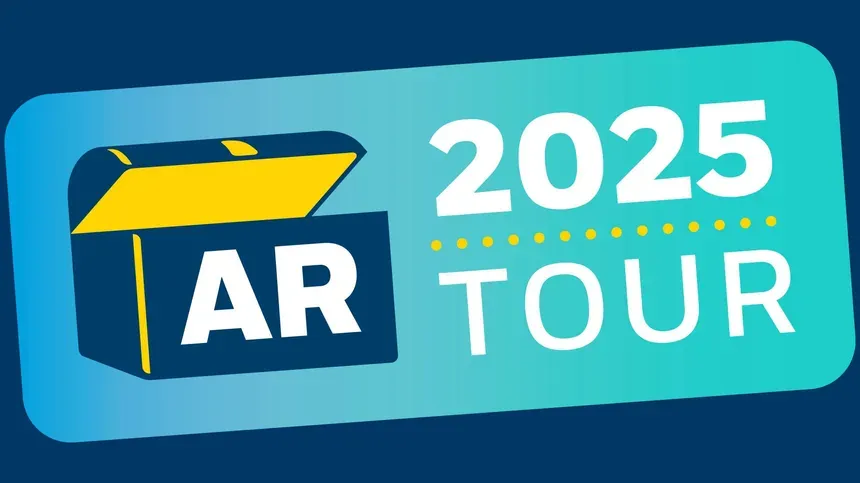
ANTIQUES ROADSHOW 2025 Tour!
Enter now for a chance to win free tickets to ANTIQUES ROADSHOW's 2025 Tour! Plus, see which cities we're headed to!Providing Support for PBS.org
Learn Moreabout PBS online sponsorshipMore from This Collection
RECUT: Idaho Botanical Garden, Part 4
Video has Closed Captions
Wrap up Season 4 of RECUT with a $50,000 appraisal at Idaho Botanical Garden! (22m 31s)
RECUT: Idaho Botanical Garden, Part 3
Video has Closed Captions
Visit the “City of Trees” for unbe-leaf-able Boise treasures in this half-hour RECUT. (22m 31s)
RECUT: Idaho Botanical Garden, Part 2
Video has Closed Captions
In this half-hour RECUT, watch breathtaking Boise appraisals at Idaho Botanical Garden. (22m 31s)
RECUT: Idaho Botanical Garden, Part 1
Video has Closed Captions
Gem State treasures sparkle in this half-hour RECUT at Idaho Botanical Garden! (22m 31s)
Video has Closed Captions
Watch wow-worthy Woodside finds in this half-hour RECUT and learn which is up to $44,000! (22m 24s)
Video has Closed Captions
In this half-hour RECUT episode, golden state treasures shine at Filoli. One is $150,000! (22m 23s)
Video has Closed Captions
Watch fascinating Filoli finds in this half-hour RECUT, including one up to $100,000! (22m 36s)
Video has Closed Captions
This season's first half-hour of RECUT wows our guests with a $200,000 to $330,000 find! (22m 30s)
RECUT: American Stories, Part 1
Video has Closed Captions
Learn the stories of objects that represent American traditions and triumphs! (22m 28s)
RECUT: Desert Botanical Garden, Part 2
Video has Closed Captions
Phoenix treasures heat up, like one appraisal up to $35,000, in this half-hour RECUT! (22m 28s)
RECUT: Desert Botanical Garden, Part 1
Video has Closed Captions
Phenomenal Phoenix finds abound in this half-hour RECUT. One is worth up to $100,000! (22m 26s)
RECUT: Crocker Art Museum, Part 2
Video has Closed Captions
See stunning Sacramento finds like one $80,000-$125,000 treasure, in this half-hour RECUT! (22m 28s)
Providing Support for PBS.org
Learn Moreabout PBS online sponsorship♪ ♪ WOMAN: My Aunt Pearl started the Aerospace Nursing Program to train nurses to take care of the astronauts.
You realize that space nerds everywhere are going crazy right now.
CORAL PEÑA: It's "Antiques Roadshow Recut: Out of This World Part Two."
♪ ♪ PEÑA "Antiques Roadshow Recut" returns with more stories that are simply out of this world.
WOMAN: The album belonged to my aunt Pearl Tucker.
She's a colonel in the Air Force.
She retired.
Unfortunately, she passed away last week.
Oh, I'm sorry, oh... And, so... At age 92.
She was very involved in the aerospace program... Mm-hmm.
And started the Aerospace Nursing Program to train nurses to take care of the astronauts.
Right, and that would be 1963, when she was assigned to do this.
Right, mm-hmm.
It looks like she made great associations with the astronauts.
There's lots of personalized cards in the albums.
She would come in and train nurses.
She usually had two nurses at a time that she trained.
Uh-huh.
Over a two-year period.
And they learned everything-- had to wear the pressure suits, they wore the pressure suits.
So they actually would have to take pressure training.
Yes.
Okay, uh-huh.
And altitude and anti-gravity.
They had to do all of that.
Okay.
And they wore the, the suits, especially, to know how to get the astronaut out of the suit if something happened, if there was an accident.
What is your aunt doing in this photo here?
She's at sea.
They had these vehicles that would go out and recover the astronauts.
Ah.
Say, if the, if the helicopter couldn't get to them fast enough.
And so they usually had two very strong swimmers on those boats, of which Pearl did not swim.
(chuckles) Tell me about the menu you have here.
Two days before their flight, they came in for training.
Pearl decided that they needed a good breakfast.
She took her china from home and she put together a nice breakfast and drew them this menu.
She loved ducks, and she always illustrated things with ducks.
Uh-huh.
And so...
It shows a real personal connection with them.
Right.
It was for Gemini 4.
And the commander on Gemini 4 would have been James McDivitt.
Uh-huh.
And Edward... And Edward White was the one that did the very first spacewalk, and McDivitt had to coax him back in because he, apparently, was having a good time.
(laughs) Borman and Lovell were the backup crew.
Later on, she's been with the mission for a while, and you see these astronauts here, you have Gus Grissom, Ed White, and Roger Chaffee, who were with the Apollo 1 disaster.
Right.
It was her job to help get them out of their flight suits after the disaster.
Right, she did, and helped with the autopsies.
Yeah.
So she died, you say, in May.
She's only been gone for about a week.
Yes, yes.
Good.
She's going to be interred in Arlington with honors.
Is she?
In reviewing all the material I saw, probably the most valuable pieces being personalized signed things from, from the astronauts, I would say a value on this entire collection, with the album which you had brought in earlier, at auction, would be $20,000 to $30,000.
Wow, gee.
(laughs) If we're looking at a value of these objects here on the, on the table, the collective of the original pieces would be this, this, and these photos here, and the book-- the value of that grouping would be $5,000 to $8,000.
Whoa.
(chuckles) She'd be really happy.
(laughs) My father was able to meet Admiral Byrd in 1927, and got his autograph.
And he decided at that point to try and get more autographs.
And he lived in Northern New Jersey.
And at that point, you didn't have to have a driver's license.
So at 12, he was able to just get in the car and drive to Teterboro.
And he hung out there, and he met all these people.
And by 1933, he had 250 to 300 autographs.
And so now it numbers 990 autographs.
Let's take a look...
Okay.
...at a few of the individual examples.
Let's start out with one of my favorites, and America's favorites, Amelia Earhart, signed shortly before she disappeared.
Yeah, right, yeah, in June of '37.
And she died, I believe, in July of '37, or was lost in... She's certainly one of the most sought-after aviation autographs there is.
Right, right.
And right below Miss Earhart, we have the famed man on the moon, Neil Armstrong.
Neil Armstrong.
How, how did he acquire this particular one?
Well, my dad worked on this through the '20s and the '30s.
And then he became involved with family and job, and at that point, my grandmother was a widow.
So she sat in her apartment in California and wrote off these letters to people.
Actually, she's the one who got Neil Armstrong.
And particularly with the Armstrong, I'm really impressed with the note he wrote on the bottom here: "I'm very pleased to have you place my name "alongside so many fine aviation pioneers.
Neil Armstrong."
Yeah.
That makes it very personal.
Yes, it does-- it does, right.
And precious, I think.
And then we've got Alan Shepard.
And then, up at the top here, we have all seven of the Project Mercury astronauts.
Right.
Signed on... On here, yeah.
...a piece of ephemera issued back in 1959, I believe.
Yeah, yeah.
Then below here, we have John Glenn's autograph.
Right.
And then Chuck Yeager below John Glenn.
Right.
Then over to the, the far side, by you...
Yes, this one.
You've got the famous Captain Eddie Rickenbacker.
Mm-hmm.
And then the famed French aviator Louis... Blériot, yes.
Blériot.
He was the first man to cross the English Channel, in 1909.
And then lastly, up at the top here, the infamous "Wrong Way" Corrigan.
Infamous "Wrong Way" Corrigan.
It's just an absolutely marvelous collection, and it extends from ballooning history in the 19th century right up to the whole period of modern aviation.
Right.
And into the astronauts of the late 20th century.
And it's, it's so comprehensive at almost 1,000 different pieces.
Right.
We can only show a fraction of the pieces here today.
Oh, a fraction, yeah, right, they're... At retail value, Amelia Earhart is $2,000 to $2,500.
The Neil Armstrong, a couple of thousand dollars.
The autograph's signed in 1961, some years prior to his walk on the moon, so his, his autograph as a moon walker would be higher percentage.
I see.
Even though this one's older, it's worth less-- I see.
Yes.
Just what we've examined today, at retail value, the collection would bring $12,000 to $15,000, and more for all the hundreds of other autographs that you have in the collection, as well.
Right, right, so is it just... Just the ones that you actually were able to... To find.
We looked at, yes.
MAN: I got this plaque out of a lady's attic.
She told me she didn't want it and put it on the street, so I asked if I could have it.
This was done by the Rookwood Pottery of Cincinnati, Ohio.
Wow.
This artist may very well be E.T.
Hurley.
The fact that this is such a moody moonscape, he could very well have done that.
WOMAN: Did you ever see anything like this?
She wanted $50, but I got her down to $35.
(laughter) Do you want to hold it?
It's heavy!
MAN: We have a bunch of photos and negatives that we purchased from a yard sale almost two years ago that are from all of the Apollo missions and Skylab.
APPRAISER: These are very exciting to see today at the Roadshow.
What we are showing here are just three of the photographs from one of the albums.
These photographs are from the Apollo 11 mission, which was the first lunar landing that, United States manned spacecraft.
What we can see here is a very iconic image of the flag on the moon.
And this is from 1969.
These are color images.
They're in wonderful condition.
And they're part of this larger group that you have, an album, which includes 20 to 25 images from this mission, in particular.
How much did you pay for these albums when you purchased them?
We paid $101.
$101.
Yeah.
And we're showing just one album, but you have a collection of them.
Mm-hmm, yes.
So this album now, at auction, I would value between $1,000 and $1,500.
Okay.
MAN: I found these toys at an aunt's house, put it away in storage for about 30 years, not really thinking it would be an important till I watched you.
I've been watching "Roadshow" for quite some time.
And I know you're the expert on toys.
The best in the world, I think.
Oh, well, I...
So...
I thank you very much.
(chuckles) Well, I love these toys, and it looks like we have a real space extravaganza here.
Space toys started coming in popularity in the late '50s, early '60s.
The best ones were made in Japan.
Mm-hmm.
These were made by a company called TN, and this was made by a company called Showa.
Two basic categories: space astronauts and space robots.
Hm.
And you have two of each.
That's pretty nice.
How about that?
So you found these in your aunt's house.
Yes.
And other people were there first, right?
Basically.
They took what they wanted as important-- this was... And left you this junk.
Well, this was under a bunch of junk.
Okay.
And I uncovered it, kind of, you know.
Of course, I'm sure, if you watch the "Roadshow," you know that we love them in the boxes.
Okay.
And we love them when they haven't been played with.
So we got a lot of love here.
What you have here is this spaceman.
They're very desirable and very collectible, especially when they're in this kind of condition.
And then the other major category are the robots.
This robot, we call him Robbie the Robot.
Oh, yeah.
Because he was based on the character in "Forbidden Planet."
But he's never called that on the box, because maybe they'd have to pay a licensing fee.
Okay.
By the way, one thing that makes these very valuable is, these little rubber hands are easily broken and lost.
Okay.
This one, as you know, has a problem.
It's missing its faceplate here.
The switch on there, right.
Now, because these are so valuable, there are people who make the replacement parts, so that would be available.
Oh, wow.
So, generally speaking, when you find these in the box, they've been selling at auction for $2,000 to $3,000 apiece.
Wow.
Each one of these.
Wow.
But few of them that have sold for that are in these kinds of conditions.
So I think that's a very conservative estimate for the values of these at auction.
This one would probably be $1,000 to $2,000, because somebody could repair that.
Okay.
So, you have some...
I have dinner.
You have dinner.
You can go, I think you can have a few dinners.
Okay.
MAN: I started out at North American Aviation as an inspector, and I worked myself up to engineer.
I started collecting the photos after Apollo 1 burned up.
When I went to the cape and the launch team, they sold us these jackets.
We didn't have to buy them, but we just all wanted to wear them, so we all bought these jackets.
Do you remember what you paid for the jacket?
Yeah, I think it was 40 bucks, which was a lot of money in the '60s.
Mm-hmm.
You know, so... so... but it was...
It was worth every penny.
What was your role with, with...
I was in quality control, I was the...
I tested everything before the astronauts would come in the, in the spacecraft.
And that's what I'm doing in that one picture there.
I'm firing these rockets right here on the service module.
This is the command module, this is the service module, and I'm firing these little 100-pound thruster engines.
How did you acquire this particular model?
Oh, it was given to me years ago.
I just earned it, like... And then, so I just started getting all the astronauts to sign it.
You've captured 15 astronaut signatures on the capsule portion of this.
Yeah, yeah, right.
And so you were friends with them all, and...
I was good friends with them.
I met them in the early '60s.
We had to go through classes together.
So I got to know them on a personal basis, and they're crazy guys, so we had a lot of fun.
Okay, and this was a North American Aviation Apollo spacecraft model.
Yes.
It's the executive model, is what it's referred to as.
Yes, yes.
Okay, now let's talk about this burnt-up sticker.
What happens is, when a spacecraft would come back to Downey, we would strip them all down, take all this stuff off them, and make them pretty.
And so this arrow, which is right here, they were scraping all this stuff off.
They were throwing it away in a big pile, so I just...
They just gave it to me.
This label was... Another guy gave that to me.
And he gave it to me because I was the final person to stamp, saying, "Hey, we've got a good product."
This is the serial number, 107, so we called it 107, and then when it went to the cape, it became Apollo 11, in this case.
So that's the serial number sticker.
Yes, for... Off of the Apollo 11 command module.
Yes.
You realize that space nerds everywhere are going crazy right now.
Well, I hope so.
(chuckles) Have you ever had it appraised?
No.
Or do you have any clue as to what these things might be worth?
No, none at all.
Space stuff is hot.
So the first thing I want to talk about is, is the jacket.
So that was your jacket, you paid $40 for it.
Yes.
You just don't see these.
If I estimated at auction today, I would guess it would sell for between $3,000 and $5,000.
Really?
(laughing): Okay.
Hm.
This model is the executive model.
Yes.
They have come up at auction before.
They have not come up with the signatures that you have.
We see there's Walt Cunningham.
There's Buzz Aldrin.
Right up here, ever so faint, is Neil Armstrong.
Yes.
We see Alan Shepard.
Alan's, Alan's one of the most well-known astronauts, but his signature's not worth that much because he signed so much stuff.
(laughs) It's fantastic.
So if we estimated this at auction today, I think conservatively, it would carry an estimate between $20,000 and $30,000.
(laughs): Okay.
I don't know if I really wanted to know that.
It just sits in my man cave.
(both laugh) Well, it's a nice thing to have in the man cave.
Yes, yes.
We have the rescue sticker.
And then this was the serial number label off the inside of the capsule door.
Inside.
If we offered the two stickers together... Mm-hmm.
You would see those with an estimate of between $30,000 and $50,000.
(laughs): Okay.
I'm donating this to my niece, so she'll be happy to hear that.
The total here would be between $53,000 and $85,000.
That's amazing.
MAN: In 1986, I started collecting astronaut autographs in this book, and I have astronauts who I met autographed by their biographies.
And then it's been signed by 122 astronauts and cosmonauts.
As a collection, I would say the book at the present moment is probably worth about $10,000.
Wow!
(laughs) WOMAN: My grandfather worked in the engineering of the spacesuits that were used in the Project Mercury.
There were seven dolls that were given to the seven astronauts.
My grandfather ended up with this one.
It's very detailed, meant to look almost identical to the original suit.
I think it's the kind of thing that at auction could bring $5,000 to $10,000.
So... Good!
So thanks for bringing it-- it's a wonderful item.
Thank you!
WOMAN: This is a necklace that was a gift that my grandfather gave to my grandmother, probably late '40s, early '50s.
APPRAISER: Did you happen to know anything about the particular stones?
I thought it was moonstones and sapphires.
Very good-- two points for you.
All right!
(laughs) Not only do you have the moonstones and the sapphires-- they are set in 14-karat gold-- but when I took a more detailed look at this piece, it's marked Tiffany.
Oh, my!
This was a piece made in the 1940s.
It's very much in the style of Louis Comfort Tiffany's work, because he, too, liked moonstones and sapphires as somewhat of a signature combination.
This is later, so it is not one of his designs, but it is certainly paying homage to the work that he did.
The beauty of this, also, is that you have options on how you'd like to wear it.
Right, this is a brooch, and you can detach that from the necklace and wear it as a brooch.
From an auction standpoint, a necklace like this would have an auction estimate of $5,000 to $7,000.
Oh, my goodness.
MAN: My friend Forrest Bess gave it to me in '62.
He lived at a bait camp.
Mm-hmm.
Where he sold bait fish for fishing down in Chinquapin, Texas.
And Forrest Bess is the artist, is that right?
Right, right.
And you knew him all through the years, or...?
Yes, way back in the early '50s.
Mm-hmm.
And before that-- I knew his mom and dad, the whole family.
Well, he must have been kind of a character.
He was.
Yeah.
He painted his dreams.
And this is one of his dreams.
He was known as a Modernist, and his work is somewhat rare.
We don't, don't see it very often.
I don't think his production was particularly heavy.
He was born in 1911 in Bay City, Texas.
And I believe he lived a little bit in Texas and Oklahoma.
He didn't really have much art training.
From what I understand, he was taught by a neighbor who lived next door.
He went to college in Texas, and he didn't study art.
He studied Greek mythology, English, and also Darwin and Freud, who came to be important to him later on.
Mm-hmm.
For a while, he opened his own studio, but then he was, like many other artists, called to, to war, and he worked for the Corps of Engineers.
Right.
And then after the war, he was called back to be in charge of his family's bait company, in the late '40s, probably.
Right.
I think he came back then, and they lived in this small... House, you might say.
Uh-huh.
Some people might say it was a shack.
Uh-huh.
But he built onto that and built it up mainly out of driftwood that he found along the beach and stuff.
Mm-hmm.
In fact, the frame of this is driftwood.
It's very interesting.
Yeah.
In the late '40s, he was discovered by a gallery owner named Betty Parsons, in New York.
Right.
Right.
And she was very interested in the avant-garde, and when she first started her gallery in 1946, she represented Jackson Pollock and Mark Rothko.
After they left her to go to another gallery, she continued to look for new artists.
And Forrest Bess happened to be one of them.
And if we look in the lower right, we see a little label, and that would probably indicate that it was in an exhibition of some sort, or in a catalogue.
And this... And as well, on the back, we have a Betty Parsons gallery label, and the price of $150.
The title here is listed as "Number 30," whereas in the artist's hand, over here on the stretcher, it says, "Untitled."
Right.
So it's possible that Betty decided to title the piece.
Yeah.
Now, you were saying that the artist liked to paint his dream.
During the day he would take naps.
Mm-hmm.
And you'd see him wake up, and he'd write something in a book and go back to sleep.
Mm-hmm.
And then he would take that and put it on canvas.
When he'd paint, he would go out and sift builders' sand through a screen bar.
Mm-hmm.
And use that sand, mixed with his paint, to give it bulk.
Oh, that's interesting, wow.
Modernist works like these are very popular.
Modernism in general is quite strong.
If this were being sold in a gallery that specialized in 20th century and this, and this period, I believe the price would be in the range of $75,000.
(laughing): You're kidding.
No.
I'm not kidding.
I would never have believed that.
That, that is unbelievable.
We thought you'd be surprised.
(stammering) I'm... blown out of my... it's just unbelievable.
♪ ♪ PEÑA: Thanks for watching.
We hope you enjoyed this episode of "Antiques Roadshow Recut."
Appraisal: 1963 - 1967 Pearl Tucker NASA Archive
Video has Closed Captions
Clip: Special | 3m 22s | Appraisal: 1963 - 1967 Pearl Tucker NASA Archive (3m 22s)
Appraisal: 1969 NASA Apollo 11 Photo Album
Video has Closed Captions
Clip: Special | 1m 7s | Appraisal: 1969 NASA Apollo 11 Photo Album (1m 7s)
Appraisal: Aviation Autograph Collection
Video has Closed Captions
Clip: Special | 3m 21s | Appraisal: Aviation Autograph Collection (3m 21s)
Appraisal: E. & G.W. Blunt Celestial Globe, ca. 1864
Video has Closed Captions
Clip: Special | 33s | Appraisal: E. & G.W. Blunt Celestial Globe, ca. 1864 (33s)
Appraisal: Flown Mercury Camera Viewfinder, ca. 1962
Video has Closed Captions
Clip: Special | 1m 3s | Appraisal: Flown Mercury Camera Viewfinder, ca. 1962 (1m 3s)
Appraisal: Forrest Bess Oil Painting, ca. 1950
Video has Closed Captions
Clip: Special | 3m 56s | Appraisal: Forrest Bess Oil Painting, ca. 1950 (3m 56s)
Appraisal: Japanese Spaceman & Robot Toys, ca. 1960
Video has Closed Captions
Clip: Special | 2m 38s | Appraisal: Japanese Spaceman & Robot Toys, ca. 1960 (2m 38s)
Appraisal: Tiffany Moonstone Necklace, ca. 1940
Video has Closed Captions
Clip: Special | 1m 17s | Appraisal: Tiffany Moonstone Necklace, ca. 1940 (1m 17s)
Providing Support for PBS.org
Learn Moreabout PBS online sponsorshipSupport for PBS provided by:
Funding for ANTIQUES ROADSHOW is provided by Ancestry and American Cruise Lines. Additional funding is provided by public television viewers.


